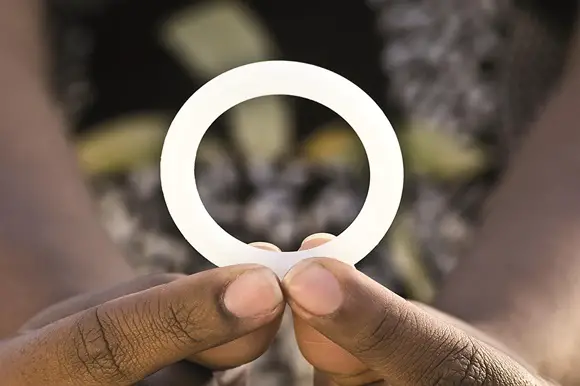Ancient Egyptians used acacia, honey and crocodile dung to prevent pregnancy, women in China drank tea made with hot mercury and Greek and Roman women coated their cervix in olive oil and cedar resin. Fortunately, no matter how much you hate whatever it is that you’re currently using, contraceptives have come a long way since powdered roots and animal skins.
Today, women have access to a myriad of methods to best suit her lifestyle, from the pill to the to the implant to the IUD. Thanks to modern forms of birth control, women are able to exercise more and more autonomy when it comes to having children. In fact, contraceptives are one of the main reasons why teenage pregnancy rates are lower than ever. As more and more people wish to engage in protected sex, the demand for safe and effective contraceptives is on the rise. While the current methods are good, there is always room for improvement. Luckily, there are a number of innovative and exciting new contraceptive products in the testing and development stages.
The range of methods currently available is matched only by their various side effects. Most methods are hormonal, which can come with side effects such as headaches, mood changes, nausea, abdominal pain, breast pain and changed libido. Deep vein thrombosis, a very rare risk of the combine pill, can be fatal. New studies have confirmed a link between hormonal contraception and depression, and some kinds of the hormonal birth control pill have been linked to increased rates of breast and cervical cancer. The DeproVera shot likely causes weight gain, and, in rare cases, IUDs can perforate the uterus or cause sepsis. Lastly, no contraceptive method besides condoms can prevent the transmission of STIs.
So, while contraceptives have a long way, every method currently on the market has its own set of drawbacks, which has kept researchers hard at work trying to develop painless new methods of preventing pregnancy, each easier, cheaper and more hassle-free than the last. Below are several of the most promising methods of birth control currently being developed.
1. The Fertility Chip
In 2014, the Bill and Melinda Gates Foundation funded the development of a new type of implant birth control that could revolutionize the field of contraceptives. Called the “Fertility Chip,” the device is a tiny microchip inserted under the skin that would release levonorgestrel over the course of sixteen years, longer than any other form of birth control on the market.
Furthermore, women would be able to remotely operate the flow of hormones themselves, meaning that they would not need to see a doctor if they wished to conceive. The Fertility Chip has enormous implications for women in developing countries, who often don’t have easy access to health care. The Fertility Chip is slated for release in 2018.
2. Origami Female Condom
The female condom is certainly not new, but designer Danny Resnic wants to reinvent it. Female condoms have long been maligned for being difficult to insert, hard to source and subject to the usual complaint male condoms receive, i.e. that they decrease sensation.
The Origami female condom, however, is oval shaped to mirror female anatomy, only expands once inserted and is pre-lubricated with a silicone based lubricant. The product is still in clinical studies.
3. Dapivirine Vaginal Ring
While the vaginal ring is not used for the prevention of pregnancy, it’s still an extremely promising product, because it has been found up to 61 percent effective at preventing the transmission of HIV. No current products on the market exist to prevent HIV, so the vaginal ring has huge implications.
The ring works by releasing a small amount of dapivirine, which prevents the HIV virus from making copies of itself. Clinical studies showed a general level of reduced risk of 37 percent, but when the results included only women twenty-five and up, the device showed 61 percent efficacy. The ring is currently still in the testing process.

Up until this point, this list has included birth control designed for women to use, which has been standard practice for practically all of human history. However, recent developments have sought to level the contraceptive playing field. Plus, since sex is a shared endeavor, it seems that it would be only fair to split the responsibility. Women not only shoulder the potential side effects and financial cost of birth control, but are also largely forced to take full responsibility for unplanned pregnancies. Why shouldn’t men also help in their prevention?
With that thought in mind, it helps to remember that men actually do have some methods of birth control at their disposal: condoms, vasectomies and the pull-out method. Condoms can be unreliable because of lower rates of effectiveness and lower rates of usage. The CDC reports that only 65 percent of men use condoms regularly, and only 59 percent of high school students said that they used a condom during their last sexual encounter in the past three months. The failure rate of condoms with typical use is 18 percent, and the pull-out method—a technique whose efficacy is hard to measure, as its implementation is highly subjective—results in about twenty-seven out of one hundred women getting pregnant over a year. A vasectomy is certainly effective, but the effects are currently irreversible.
A safe, effective, reversible form of male birth control would certainly have few competitors, but the market is exceedingly empty. Pharmaceutical companies don’t see a large profit in male contraceptives, as they fear that they will infringe on the wildly lucrative market of female birth control. Another factor in their conspicuous lack of existence could be that contraception has for so long been perceived as a “female” issue that few men express a demand for male products. Or, as Julie Beck states in “The Atlantic,” “Perhaps the hurdle that remains is that male birth control is unlikely to substantially improve a man’s quality of life. He can already avoid unwanted pregnancies if his partner is on birth control; with his own he’d get the same advantages, except now he might have mood swings.” Despite these obstacles, there are a few products for men being developed that show great promise.
1. Vasalgel
Vasalgel prevents pregnancy through a polymer gel that is injected into the vas deferens. The gel keeps sperm from getting through by creating a barricade.
Studies have shown Vasalgel to be remarkably effective—when tested on Rheus monkeys over a two-year period, none of the female monkeys conceived. When tested on rabbits, semen samples displayed no signs of sperm during the yearlong trials. Vasalgel is easily reversible with an injection of sodium bicarbonate. The first clinical trial is expected to being in 2018.
2. Gamendazole
Gamendazole is a male birth-control pill that keeps sperm from reaching maturity and allows the little guys to then be reabsorbed into the testes. Male rats have shown 100 percent infertility after taking the pill.
The effects of Gamendazole are reversible eight-to-ten weeks after the drug is stopped. Further research must be done to establish if Gamendazole can affect a women’s body, and the drug is awaiting pre-clinical safety and efficacy trials.
3. Clean Sheets Pill
The Clean Sheets pill is a hormone-free method that works by relaxing the muscles, which creates lengthwise contractions along the vas deferens, meaning men can still achieve orgasm, but the release of semen is inhibited. Not only is the pill, which can be taken in single doses, promising for preventing pregnancy, but it also stands to reduce the risk of transmitting HIV, which makes it useful for the gay community as well. The Clean Sheets pill has shown promising results in animal studies, but due to lack of funding, the research has been unable to progress further.

A recent male birth control study seemed promising, showing 96 percent efficacy. However, the study was stopped because the participants suffered from symptoms such as mood swings, depression, muscle pain, acne and changed libido, symptoms that, coincidentally, are the same side effects that female birth control has produced for the past sixty years. Still, 75 percent of the men said they would use this birth control in the future.
One of the other questions brought to light by male birth control was whether or not women would trust men to consistently take it. In a small study conducted in London, more than half of the women interviewed said they would not. The obvious counterpoint is that currently men must trust the women they are sleeping with to keep up consistent contraceptive habits. However, the difference lies in that women are the ones who bear the consequences of imperfect use. Women have a huge incentive to maintain proper contraceptive use. Would men necessarily feel the same pressure, the same fear? Probably not.
The current state of contraceptives is certainly not perfect. Wide ranging side effects and an unfair distribution of responsibility on women are two of the major problems. However, new developments in technology show that the future is hopeful. Reduced side effects, non-hormonal methods, a reduction in HIV transmission and a sharing of the responsibility could all be possible. Women must hold onto hope, as the only other option is to keep putting up with it.


















Help us in the way for all those who don’t like condoms and using the pullout method. Is too risky
Jiftip the DikTip is now beta.